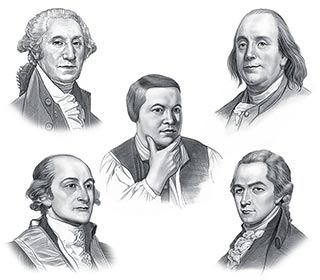Government in the North Colonies
All of the systems of government in the New England Colonies elected their own legislature, they were all democratic, they all had a governor, governor's court, and a court system. The government systems used by the North Colonies were Royal of Charter. Definitions of the government systems are as follows:
- Royal Government: The Royal Colonies were ruled directly by the English monarchy
- Charter Government: The Charter Colonies were generally self-governed, and their charters were granted to the colonists.
For additional facts and information refer to Colonial Government.
Religion in the North Colonies
The religion practised in North was strictly Puritan and they did not tolerate any other religions - refer to Pilgrims and Puritans and Religion in the Colonies.
Original Names of the North Colonies
The original names of the North Colonies were the Province of New Hampshire, later New Hampshire, the Province of Massachusetts Bay, later Massachusetts and Maine, the Colony of Rhode Island and Providence Plantations, later Rhode Island and the Connecticut Colony, later Connecticut.
The North Colonies Timeline
Discover interesting information and facts about the history of the North. For a more comprehensive history timeline detailing specific events relating to all of the 13 Colonies refer to Colonial America Time Period. This North Colonies Timeline provides a list detailing key events and dates of this amazing period in Colonial history. The four North Colonies of Colonial America included the colonies of New Hampshire, Massachusetts Bay Colony, Rhode Island and Connecticut.
1620: The Pilgrim Fathers, or Pilgrims, founded the second colony of Plymouth in North in 1620, located in present-day Plymouth, Massachusetts, United States. The Mayflower Compact was a legal document written by the Pilgrims to specify basic laws and social rules for their new colony. In 1624, Virginia was made a royal colony.
1620: The Pilgrims, the founders of Plymouth, arrived in 1620. John Mason and Sir Ferdinando Gorges, the "Father of English Colonization in North America" had received land in the North which became the Massachusetts Bay Colony. John Mason eventually formed New Hampshire and the land of Sir Ferdinando Gorges led to Maine. Massachusetts Bay Colony controlled both regions until New Hampshire was given a royal charter in 1679 and Maine was made its own state in 1820.
1636: Connecticut was initially settled by colonists, led by Thomas Hooker, he left the Massachusetts Bay Colony due to dissatisfaction and settled in the Connecticut River Valley. In 1639, three settlements joined to form a unified government creating a document called the Fundamental Orders of Connecticut, the first written constitution in America. King Charles II officially united Connecticut as a single colony in 1662.
1636: Rhode Island. Roger Williams was banished from the Massachusetts Bay Colony and founded Providence. Anne Hutchinson was also banished from the Massachusetts Bay Colony and she settled Portsmouth. Two additional settlements were also formed in the area. All 4 settlements received a charter from England creating their own government eventually called Rhode Island.
1662: King Charles II officially united Connecticut as a single colony
1679: New Hampshire. John Mason received land in the North Colonies which formed the Massachusetts Bay Colony. John Mason eventually formed New Hampshire when the region was given a royal charter in 1679
1686: Formation of the Dominion of New England - King James II combines the colonies of Connecticut, Massachusetts Bay Colony, Plymouth, Rhode Island, New York, New Hampshire, East Jersey and West Jersey into a single colony: The Dominion of New England, see Charter Colonies for additional info
1688: King James II appoints Sir Edmund Andros to serve as Captain General and Governor in Chief of New England (North Colonies). Sir Edmund Andros causes dissension with the colonists as he does not have to answer to any elected assembly
1688: 1688 - 1763 The French and Indian Wars between France and Great Britain for lands in North America
1689: Mar 1689 Glorious Revolution Sparks Revolt in the colonies. Boston militiamen seize Governor-in-Chief Andros and put him in jail. The North colonies begin to re-establish governments. Jacob Leisler (1640-1691) was a German immigrant who led the insurrection against local colonial officials from 1689 to 1691 in colonial New York
1691: Plymouth joined with the Massachusetts Bay Colony
1691: Salem Witchcraft Trials - Hysteria over witchcraft accusations consumes Salem Village, Massachusetts
1696: 1696 Salutary Neglect. The British government establishes the Board of Trade to oversee colonial policies practicing a policy of "Salutary Neglect," in which it gives the colonies considerable freedom in economic matters.
1722: Wabanaki-New England War of 1722–1725 aka Father Rale's War or Lovewell's War in Maine
1763: The Royal Proclamation of 1763 was issued October 7, 1763 bringing the introduction of the massive boundary, which was the Proclamation Line between the colonies and Indian Territories
1765: 1765 The Stamp Act of 1765
1765: The Sons of Liberty was an an organization (a secret society) formed by American Patriots who opposed British measures against the colonists, and agitated for resistance
1767: 1767 Townshend Acts
1770: March 5, 1770: The Boston Massacre during which British troops killed 5 Boston civilians.
1773: Tea Act
1774: December 16: The Boston Tea Party - Massachusetts patriots dressed as Mohawk Indians protested against the British Tea Act
1775: The American Revolution (1775- 1783) started when shots were fired at the Battle of Concord
1776:
A document declaring the US to be independent of the British Crown was signed on July 4, 1776, by the congressional representatives of the 13 Colonies
